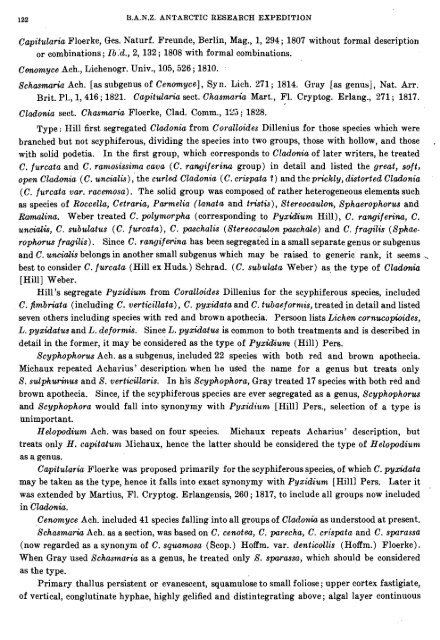Create successful ePaper yourself
Turn your PDF publications into a flip-book with our unique Google optimized e-Paper software.
122 B.A.N.Z. ANTARCTIC RESEARCH EXPEDITlON<br />
Capitularia Floerke, Ges. Naturf. Freunde, Berlin, Mag., 1, 294; 1807 without formal description<br />
or combinations ; Ib:d., 2, 132 ; 1808 with formal combinations.<br />
Cmomyce Ach., Lichenogr. Univ., 105,526 ; 1810.<br />
Schasmaria Ach. [as subgenus of Cenomyce] , Sy n. Lich. 271 ; 1814. Gray [as genus], Nat. Arr.<br />
Brit. Pl., 1,416 ; 1821. Capitularia sect. Chasmaria Mart., F1. Cryptog. Erlang., 271 ; 1817.<br />
Cladowia sect. Chasmaria Floerke, Clad. Comm., 125 ; 1828.<br />
Type: Hill first segregated Cladonia from Coralloides Dillenius for those species which were<br />
branched but not scyphiferous, dividing the species into two groups, those with hollow, and those<br />
with solid podetia. In the first group, which corresponds to Cladonia of later writers, he treated<br />
C. furcata and C. ramosissima cava (C. ramgiferdnu group) in detail and listed the great, soft,<br />
open Ckhia (C. uncialis), the curled Cladonia (C. crispata 5) and theprickly, distorted Cldonia<br />
(C. furcata war. racemosa). The solid group was composed of rather heterogeneous elements such<br />
as species of Roccella, Cetraria, Parmelia (lanata and tristis), Stereocaulon, Sphaerophorus and<br />
Ramtcclina. Weber treated C. polymorpha (corresponding to Pyxid;ium Hill), C. rangiferimz, C.<br />
uncidis, C. subulatus (C. furcata), C. paschalis (Stereocaulon paschde) and C. frayilk (Sphaerophorw<br />
fragilis) . Since C. rangiferina has been segregated in a small separate genus or subgenus<br />
and C. uncidis belongs in another small subgenus which may be raised to generic rank, it seems ,<br />
best to consider C. furcata (Hill ex Huds.) Schrad. (C. subulata Weber) as, the type of Cladmbia<br />
[Hill] Weber.<br />
Hill's segregate Pyxidium from Coralloides Dillenius for the scyphiferous species, included<br />
C. fimbriata (including C. verticillata), C. pyxidata and C. tubaeforntis, treated in detail and listed<br />
seven others including species with red and brown apothecia. Persoon lists Lichsn cornucopioides,<br />
L. pyxidatus and L. deforntis. Since L. pyxidatw is common to both treatments and is described in<br />
detail in the former, it may be considered as the type of Pyxidiumr (Hill) Pers.<br />
Scyphophorzcs Ach. as a subgenus, included 22 species with both red and brown apothecia.<br />
Michaux repeated Acha~ius' description: when he used the name for a genus but treats only<br />
S. sulphurhtus and S. vertkdlasis. In his Scyphophora, Gray treated 17 species with both red and<br />
brown apothecia. Since, if the scyphiferous species are ever segregated as a genus, Scyphophorus<br />
and Scyphophora would fall into synonymy with Pyxidiz~nt [Hill] Pers., selection of a type is<br />
mimportant.<br />
Helopodiunt Ach. was based on four species. Michaux repeats Acharius' description, but<br />
treats only H. ~apita~tunt hlichaux, hence the latter should be considered the type of Helopodiunt<br />
as a genus.<br />
Capitularia Floerke was proposed primarily for the scyphiferous species, of which C. pydata<br />
may be taken as the type, hence it falls into exact synonymy with Pyxidium [Hill] Pers. Later it<br />
was extended by Martius, F1. Cryptog. Erlangensis, 260 ; 1817, to include all groups now included<br />
in Cladonia.<br />
Cenomyce Ach. included 41 species falling into all groups of Cladonb as understood at present.<br />
Schasmaria Ach. as a section, was based on C. cenotm, C. parecha, C. crispata and C. sparassa<br />
(now regarded as a synonym of C. sqzmmosa (Scop.) Hoffm. var. denticollis (Hoffm.) Floerke).<br />
When Gray used Schas?naria as a genus, he treated only S. sparassa,, which should be considered<br />
as the type.<br />
Primary thallus persistent or evanescent, squamulose to small foliose ; upper cortex fastigiate,<br />
of vertical, conglutinate hyphae, highly gelified and distintegrating above; algal layer continuous

















